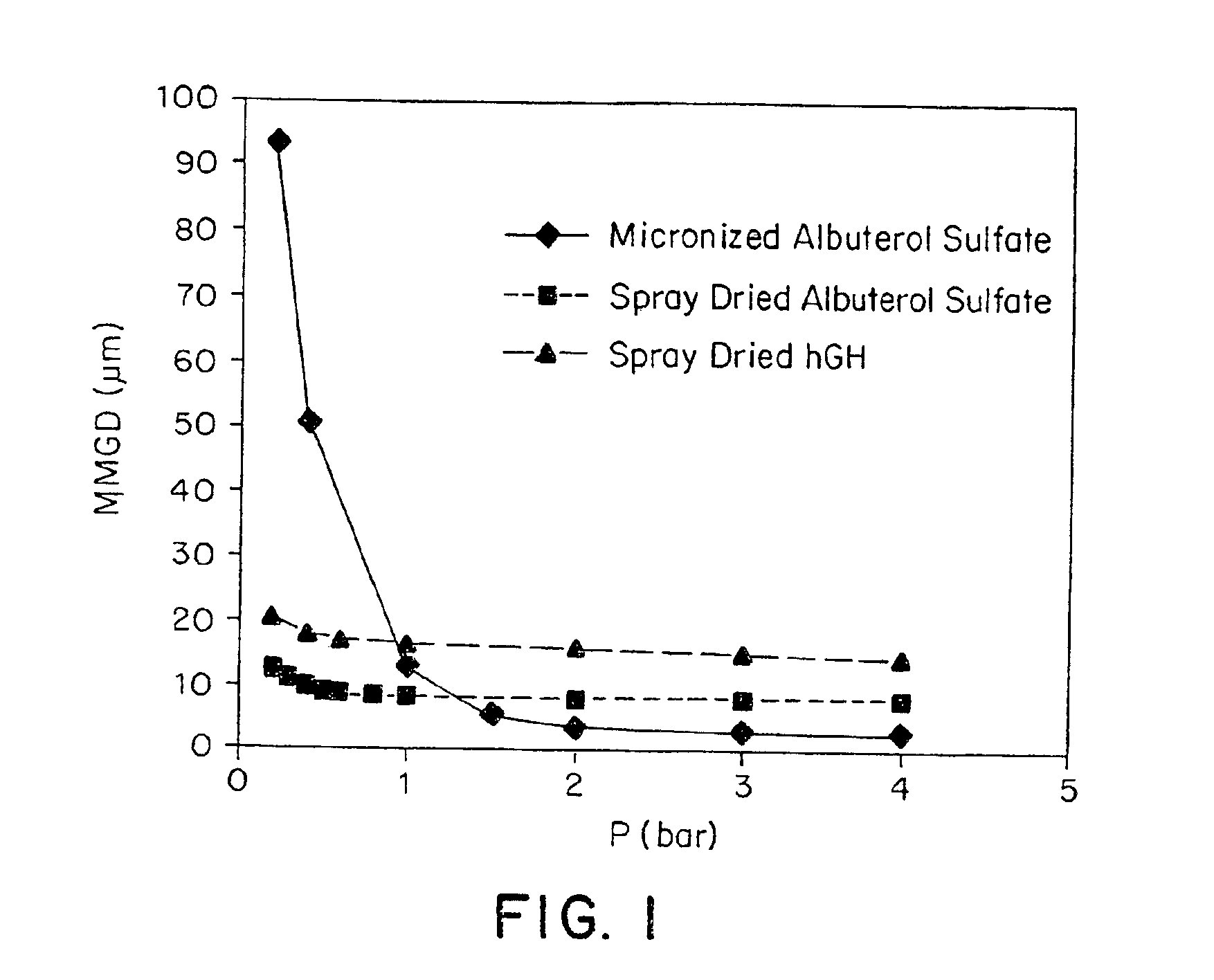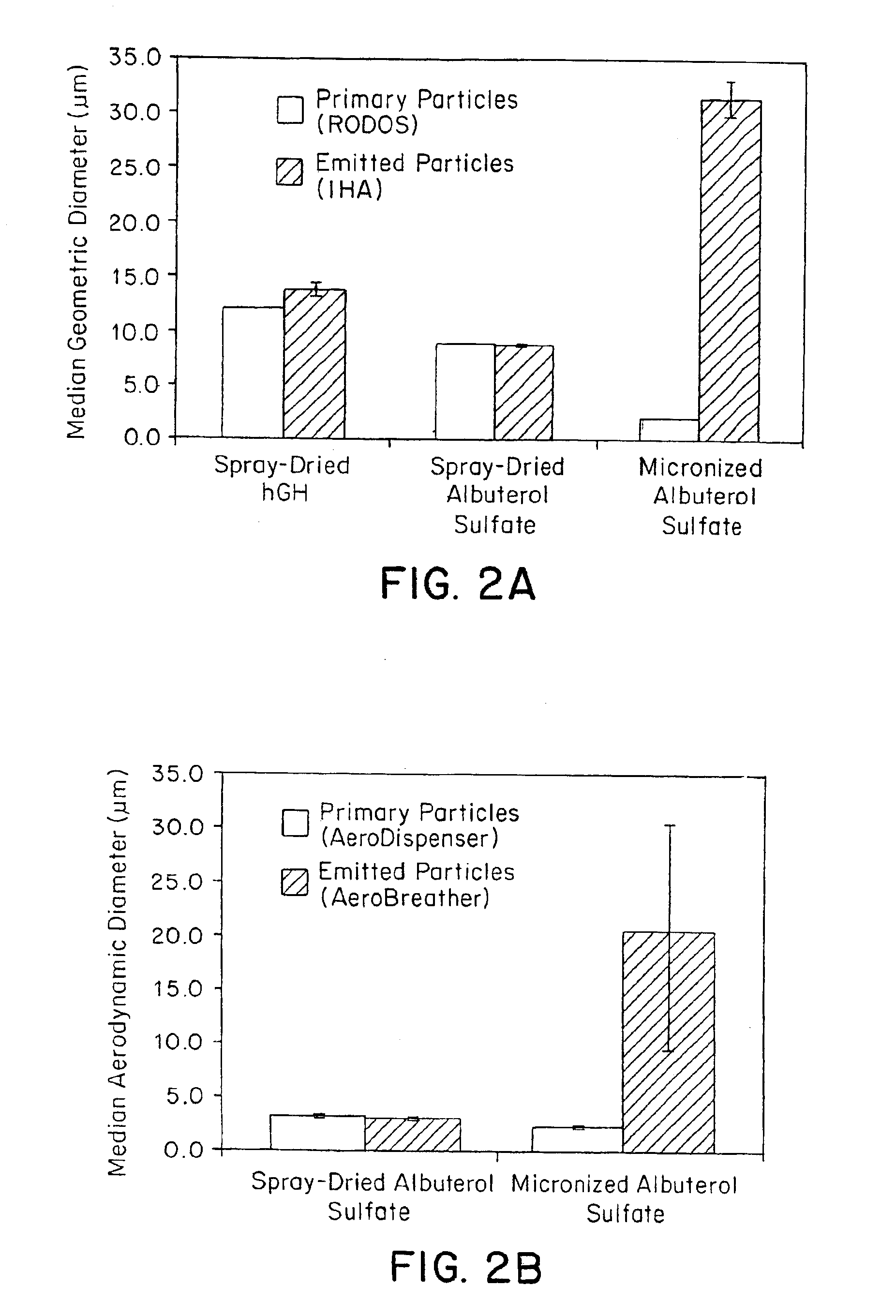Highly efficient delivery of a large therapeutic mass aerosol
a technology of aerosol and large therapeutic mass, which is applied in the direction of aerosol delivery, drug composition, peptide/protein ingredient, etc., can solve the problems of lack of reproducibility of therapeutics, poor control of the site, and excessive loss of inhaled, and achieves simple, high efficiency, and cost-effective devices.
- Summary
- Abstract
- Description
- Claims
- Application Information
AI Technical Summary
Benefits of technology
Problems solved by technology
Method used
Image
Examples
example 1
[0117]The powders suitable for use in the methods of the instant invention are required to possess properties which exhibit good aerosolization from a simple inhaler device. To determine the properties, Applicants characterized three different dry powders believed to have different deaggregation properties. The first powder to be tested was micronized albuterol sulfate particles obtained from Spectrum Labs. The second and third powders were prepared by spray-drying by dissolving a combination of excipients and a bioactive agent in an ethanol / water solvent system.
Preparation of Microparticles
[0118]Placebo particle composition is 70 / 20 / 10% DPPC / sodium citrate / Calcium chloride 0.2 grams sodium citrate and 0.1 grams calcium chloride were dissolved in 0.11 liters water. A DPPC solution in ethanol was prepared by dissolving 0.7 g DPPC (DL-α-phosphatidylcholine dipalmitoyl, Avanti Polar Lipids, Alabaster, Ala.) in 0.89 liters of 95% ethanol. The sodium citrate / calcium chloride solution and...
example 2
[0132]To illustrate that a highly dispersing powder can efficiently emit and penetrate into the lungs from a range of breath-activated dry powder inhalers (DPIs), Applicants prepared a spray-dried powder comprised of sodium citrate, DPPC, calcium chloride buffer, and a trace amount of a rhodamine fluorescent label. The powder possessed a median aerodynamic diameter of 2.1 μm (measured by the AeroDisperser and Aerosizer) and a geometric diameter of 11.0 μm (measured using the RODOS / HELOS) and displayed excellent deaggregation properties similar to the spray-dried powders in Example 1.
[0133]Applicants placed 5 mg of the powder in the capsules using a semi-automated capsule filling device in the following inhalers: a breath activated inhaler under development by the applicant AIR Inhaler, the Spinhaler® (Fisons, Loughborough, U.K.), Rotahaler® (Glaxo-Wellcome, RTP, NC), FlowCaps® (Hovione, Loures, Portugal), Inhalator® (Boehringer-Ingelheim, Germany), and the Aerolizer® (Novartis, Swit...
example 3
[0135]A human deposition study was performed to determine whether a highly dispersible powder emitted from a simple breath-actuated inhaler could produce highly efficient delivery to the lungs (>50% of the nominal dose). Powders possessing the following characteristics were used: Dg=6.7 μm; ρ=0.06 g / cc; Da=1.6 μm.
[0136]The powder was labeled with 99mTc nanoparticles.
Human Deposition Studies
[0137]Gamma scintigraphy is an established methodology for assessing the pattern of deposition of inhaled particles. In this example the test substance is labelled with a small dose of the radioisotope 99mTc at the InAMed laboratories (Gauting, Germany). Determination of the lung border is enhanced by undertaking an 81mKr ventilation scan. Inspiratory flow rates were monitored to ensure that a deep, comfortable inhalation has been performed during the deposition study. The range of peak inspiratory flow rates (PIFR) for a deep comfortable inhalation through the breath activated inhaler was assesse...
PUM
| Property | Measurement | Unit |
|---|---|---|
| tap density | aaaaa | aaaaa |
| geometric diameter | aaaaa | aaaaa |
| volume | aaaaa | aaaaa |
Abstract
Description
Claims
Application Information
 Login to View More
Login to View More - R&D
- Intellectual Property
- Life Sciences
- Materials
- Tech Scout
- Unparalleled Data Quality
- Higher Quality Content
- 60% Fewer Hallucinations
Browse by: Latest US Patents, China's latest patents, Technical Efficacy Thesaurus, Application Domain, Technology Topic, Popular Technical Reports.
© 2025 PatSnap. All rights reserved.Legal|Privacy policy|Modern Slavery Act Transparency Statement|Sitemap|About US| Contact US: help@patsnap.com



